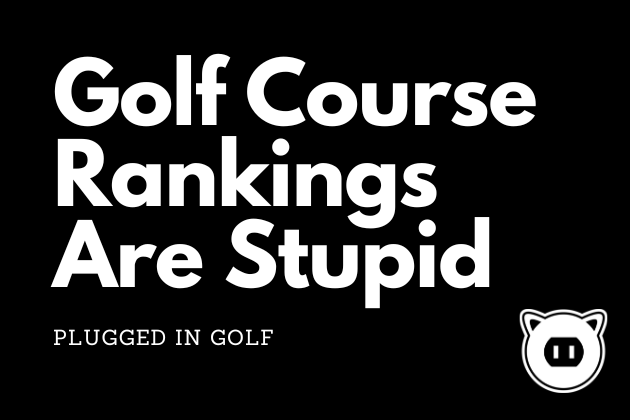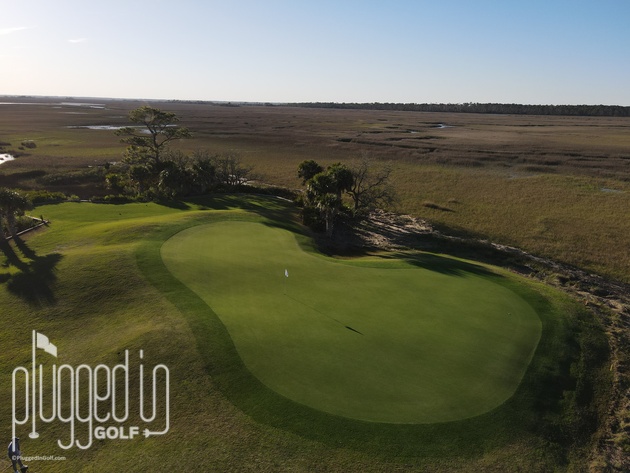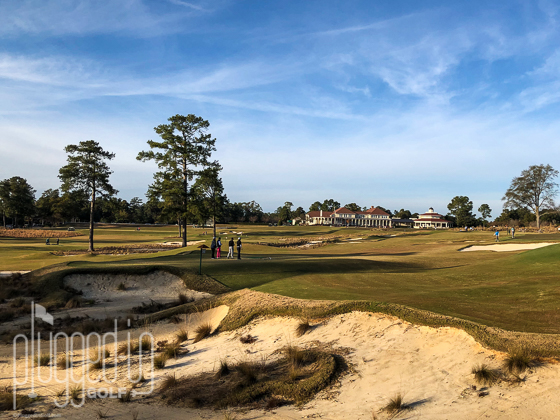
Golf Course Rankings Are Stupid
People love lists, but they rarely make us smarter or happier. This is certainly true in the world of golf. The best known list of golf equipment is nothing but a glorified participation trophy for every OEM that buys ad space, but my ire today is fixed on a different set of lists – those that purport to rank golf courses. My hope is that after you read this, you’ll join me in ignoring them.
Listen to the podcast version of this article HERE

What Are We Ranking?
The stupidity of golf course rankings starts to become obvious with the question above. Most publications share their ranking criteria, but that only illustrates the inanity of the lists.
There are numerous ways that we can rank golf courses. We can choose the most historically significant or rank them by the tournaments they’ve hosted. We might pick the most beautiful, the most difficult, the most perfectly conditioned, or the ones with the greatest variety of holes, and this is only a small sampling of the possible criteria. But to smash all of these things into one number, to say flatly, “Course X is better than all others,” is to miss the forest for the trees.
Would anyone make a list of “Best Spouses”? Of course not. Being a good life partner is a mixture of dozens of different things. Could I conjure a list of qualities, assign them all a numerical weight, and then make the list anyway? I could, but it would not make my list any less stupid.
Even if we accept the concept of making this list, what criteria are we using and how do we weight them? For me, course conditions are a non-factor, but I know many golfers for whom it’s the defining characteristic. Golfers with a love of history may care that a course was home to a famous golfer or tournament; others may wonder why that ever enters the conversation. And that’s before we get to the issue of…

Different Tastes
Even if we selected a single criteria for a list, creating a “definitive” ranking is a fool’s errand. People have different tastes.
This was brought into stark relief on our recent PIG retreat to Fripp Island Resort [learn more HERE]. After our first day of 36, we sat in our house and debated the respective merits of the two courses. Even on a topic as seemingly fact-based as course conditions, we could not reach a consensus. Two people felt the courses were dramatically different in conditions; two believed them to be peers. This group, for what it’s worth, is comprised of four people who are all above average players who have played “good” and “bad” courses across the country.
Subjectivity is present in virtually every criteria that you could use to rank golf courses. What is beautiful? What makes a course historically significant? What constitutes a fun or varied layout?
“But the list is a compilation of many peoples’ opinions, so that makes it meaningful.”
No, what it does is crush the soul out of the opinions of dozens or hundreds of players by turning them into a single number. Said another way, it is…

The Destruction of Nuance
A large part of my issue with golf course rankings is the finality of them and the way in which they destroy nuance. What a person likes or dislikes about a golf course is unique to them.
One of the great discussions in golf is, “What is your favorite course at Bandon Dunes?” [the PIG Staff debated that HERE]. A large part of what makes that conversation so wonderful is that no one – at least no one I’ve ever crossed paths with – has ever referenced a stupid course ranking during the discussion. Golfers use the topic to explore what they value in a golf course and to understand the perspective of others. I love Sheep Ranch for it’s replay-ability. You may love Bandon Dunes for its history, the thought of it being the only course on this wild landscape. The next time we play those courses, we can appreciate the other’s choice more as we see the course through another lens. It’s a discussion that makes everyone love the game more. It’s the anti-ranking, and it’s beautiful.
In contrast, course rankings are like GOAT debates. I’ve never walked away from a LeBron vs. Jordan argument loving basketball more. The premise of that debate pits me against you in a right vs. wrong framework. It leads to us tearing down what someone else loves rather than appreciating their view or simply enjoying what we like. It’s great for ESPN’s ratings, but how does it serve us?

What Is the Purpose?
Zooming out to a more philosophical point: golf course rankings are stupid because they don’t have a good purpose.
Golf course rankings are not a useful guide for where to play. Every single golfer I know has stories of playing a “highly rated” course and hating it. They’ll bookend that story with one about a course they love that’s never sniffed a Top 100 list. Why is this the case? For all the reasons we just discussed: the rankings are meaningless.
Golf course rankings do serve as a substitute for taste and developing your own opinion, but I wouldn’t count that as a good purpose. I suspect we all know a couple of gasbags who are quick to boast that they’ve played some number of the Top 100 courses. Those same clowns couldn’t tell you what they liked or disliked about any of them, nor could they name a single course that’s off the beaten path.
Rankings feed the egos of those who belong to or regularly play highly rated courses, but that seems like an awfully poor raison d’etre to me.
So that leaves us with the real reason that golf course rankings exist: to make money for the magazines. I’ll get in depth on that after a short detour.

Some Truths About Course Raters
Before getting into this, I want to be clear that nothing here is written to disparage the individual course raters. I have met numerous course raters, and I expect some PIG readers are course raters. I’ve found most of them to be good people, and some of them are my friends. Onward.
Golf course rankings are not handed down from on high. They’re created by publications which get their information from an army of course raters. These course raters are regular golfers like you and me.
That information alone may come as a surprise to many. There is no secret society of golf savants who know the great secrets of golf course architecture. The opinions of these raters is no more or less valid than yours. Yes, they are generally low handicap players (every publication has its own criteria), but, again, that does not give their opinion more weight than yours.
Why do regular golfers spend time, effort, and – of course – money to rate courses? Access. Being a golf course rater for one of the big publications can get you access to private courses which most would otherwise never get to play. Again, this isn’t to impugn the course raters; there are several private courses I would like to play, too. It’s simply to emphasize that these are normal people responding to an incentive.
Another ugly truth about the ratings is that they reward inertia. If a rater turns in a score that differs too much from the rest of the group, their rating may be thrown out and they might even lose their position. If you, having spent time and money to attain a spot as a rater, were told that you might lose your spot if you, for example, gave Pebble Beach a mediocre rating, would you? Most wouldn’t. This practice further stomps the soul out of these lists, telling each individual that there is a right and wrong answer.

Hey, Must Be the Money
“Matt, if ranking courses doesn’t make sense, why do they do it?”
To quote one of my favorites, Tony Kornheiser, quoting Don Ohlmeyer, “The answer to all your questions is money.”
Golf course rankings are a huge money maker for the magazines that create them, which is why every big publication does at least one (and most do more than one – Top X in the World, in the US, Public, Private, etc). And the different ways that the lists create revenue may surprise you.
Perhaps most obviously, these lists generate a lot of interest. People love lists. That means magazines sold and links clicked. More clicks mean more ads mean more money.
Next, have you ever noticed how the golf courses that buy a lot of ad space always end up on these lists? Funny how that works. A brand new course jumps into the Top 100 following a months-long ad campaign. That’s quite a coincidence. And that sponsorship commitment will stay in place once the course is on the list, lest that spot be given to another. “Nice ranking you got there. Be a shame if something happened to it.”
Those courses often pay on both ends. Having attained this vaunted status, they will want to put the Top 100 logo on their website and promotional materials. Do you think they get to use those logos for free? Think again.
Finally – though I may be missing other revenue streams – the raters pay the publications. Every publication I’m aware of charges the raters for the privilege of rating courses. Some take it a large step further, demanding that the raters attend pricey conferences every few years to maintain their status.

The Alternative to Golf Course Rankings
“But Matt, what will I do if I don’t read these lists?” I have some radical suggestions.
Trust yourself. Make your own lists. Tell your own stories.
I get the allure of lists and the ability to show your “taste” and “status” by rattling off how many top courses you’ve played, but wouldn’t it be more interesting to tell people about a “no name” course that you discovered and what makes it great?
Wouldn’t the discussion be richer if we talked about the three courses you’d most like to play again rather than just enumerating how many “ranked” courses you’ve been to?
Wouldn’t the trip be more fun (and probably more affordable) if it led somewhere you’d never heard of?
Wouldn’t we all love golf more if we helped each other to see what we loved in our favorite places rather than arguing about what is “best”?
I know it’s radical, but I think it’s a good idea.
Share your thoughts on course rankings below
He founded Plugged In Golf in 2013 with the goal of helping all golfers play better and enjoy the game more.
Matt lives in the northwest suburbs of Chicago with his wife and two daughters.
- Performance Golf Click Stick Training Aid Review - October 18, 2024
- Callaway Opus Platinum Wedge Review - October 17, 2024
- When to Take a Break from Golf - October 15, 2024














17 Comments
I get the rant but it’s like any other publicized ranking. One example are restaurants reviews. Like food reviewers are pampered from new restaurants because they rely on good reviews for revenue and popularity.
I would rather have a ranking then splay all of them out, glamorizing them with their subsequent ads like how golf digest do their best club rankings. That gives me no relevant feedback on a potential club I like to purchase.
Just like with club reviews or any other product I gather reviews from different sources and make a decision based around budget, travel time, location, personal reasons, etc.
And personally, I had great experiences playing a “Top 100” than not. One recently comes to mind is gamble sands. After cross referencing several rankings and reviews, I determined it was worth my while to commit a day of a golf trip and make the 3.5hr drive and it was great. Without those references how in the world am I going to know about this random course made from an orchard field in the middle of nowhere Washington. lol
Glen,
I think reviews are great – they can be a wonderful source of information about new courses and where you might want to play. My article is about rankings, which are useless.
-Matt
Eh, if the greens and bunkers are in bad shape, or it doesn’t drain well when it rains (say, Seattle in the winter). Ratings help when you are trying to figure out where you spend your money.
I would go with Matt’s response to another poster: ratings are not reviews. In my opinion reviews on apps like Golf Now, 18 Birdies, Swing U, or whichever (even Yelp! or Google, I suppose) would probably better answer the question of where to spend the money.
I agree rankings can be developed for the wrong reasons. It’s like when your wife asks you if you like her meatloaf. You can tell her the truth and accept the consequences, or you can try to find ways to make her feel good yet let her know you don’t want to have it again. I’ve played courses because they were on a “list”. Some were worth it, and some were not. I belonged to a course that after paying for a large advertising program was rated as one or the fastest to play. The problem was we constantly experienced five-hour rounds when the course was practically empty. There are other courses, that won’t be found on any lists, but I will play every chance I get because of experiences I have had there. It may have been a special round of golf or maybe just one shot that I want to duplicate. Either way lists can be helpful providing opinions from other people. But remember that even playing a bad course is usually better than playing no course at all.
For years in Canada, St. George’s and the National flipflopped #1 and #2 in the country. Both private. Irrelevant to my Greater Toronto golf life…
“Irrelevant” is a wonderful word. So many of these courses are behind doors that will never be opened to 99.9% of golfers. That reminds me of a policy Malcolm Gladwell proposed on his podcast, but I’ll save that for another day.
-Matt
totally relevant thoughts. I will look at ratings, but rankings are another story. I absolutely love a few courses that wouldn’t even be considered for a ranking. I guess I pretty much appreciate all golf courses. The main thing that would keep me away….pace of play.
Greg,
That’s a big factor for so many players…and something you’ll NEVER see a major publication talk about.
Best,
Matt
I generally agree with your point, although rankings can be useful in pointing folks to some courses that they might not otherwise choose to play. I definitely agree that a specific ranking in a publication is less meaningful than informed but mostly subjective opinions from serious golfers who have played the courses that they are comparing. I know why I like Cypress Point more than Pebble Beach, and I know why some of my friends like Spyglass Hill more than Pebble. I would add that I have always found an obsession to play at a Top 100 course so that you can check it off of a list to be silly. There are so many great courses not on those lists, and for me, as an older golfer, some on the list are simply too hard for me to really enjoy.
Matt – could not agree more. Group think and monekey see monkey do have become the norm. Nice to see an independent thinker for a change. The beauty of golf is playing where you are. I’ve enjoyed playing my home courses, and playing courses where I’ve been on non-golf vacations much more than chasing rankings, so people can say “I’ve played this and I’ve played that.” Hate to see you original thinking referred to as a rant. I’ve played Streamsong, played in Ireland , and my favorite golf courses are one course on the Oregon course Gearhardt, and a course in a small town in inland Maine. Thank you for your timely writing
Before rankings people thought the best courses were wherever the pros played. No one had heard of Fishers Island. Now social media showcases courses, but rankings showcased them prior to social media.
The purpose of rankings for publications is attention. The reason it gets attention is people are interested in identifying architecturally significant courses. Just because a course on a Top 100 list isn’t that fun, doesn’t mean the list serves zero purpose. I don’t agree with restaurant rankings, but I use the list to identify potential restaurants to visit. Golf week is 400 courses deep, showcases a lot of courses many people haven’t heard of. Whether something should be ranked 35 or 45 is very subjective, but saying your local muni is better architecturally than Cypress is not as subjective, it’s a bad opinion.
I think publications should cone out with Top 100 Fun Courses. That’s subjective too, but would be an interesting list to read and talk about with other golf course enthusiasts. That’s a good purpose.
The problem with the Golf Digest Top 100 Fun courses list is going to be that the top 100 are the ones who pay for the ranking folks to come out and not necessarily what the regular player there thinks.
Thanks, Stu!
I completely agree!!
I played a few amazing courses who don’t have a prayer to get on the list, and others on the list that are ‘good’.
Golf Club Atlas is a fantastic resource with their take and pictures.
Thanks for all you do!
I think the most important part of your article is the fact that the rankings are revenue generators and exist solely for that purpose. The fact that I am now aware of how the rankings really work makes them even more suspect and meaningless than previous for me. The pictures of the courses are very pretty, but I’d never go play one based on the ranking in a golf magazine. or those pics. In fact, many of those courses are laid out to be so difficult that to go play them would be a waste of time and money. I thought, a few years ago, that there was a movement to make these destination courses more playable for the average golfer. I guess that went by the wayside. My own personal course ranking always has to do with how I tend to play (score) on that course and the friendliness of the staff.
I just like playing golf. A big part of the have is venturing out on new tracks, of any type of testing or tanking.
In fact – I might *avoid* well ranked courses if that means they are too pricey or too crowded .. or both. But I agree – to each his own, beauty is in the eye of the beholder, whatever floats your boat, etc etc.